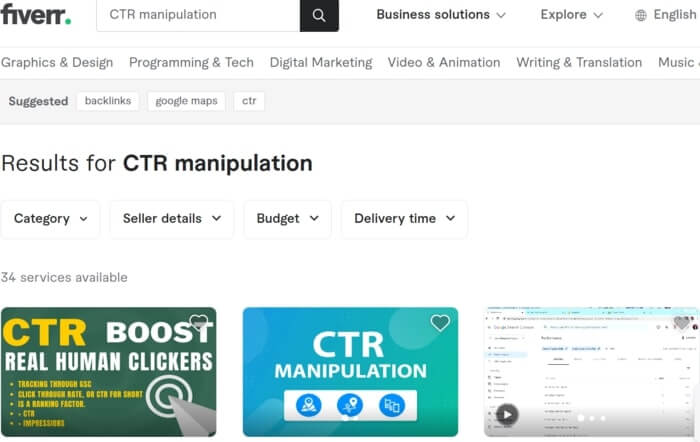Supercharge Your Link Structure Efforts with LinkDaddy CTR Manipulation Know-how
Supercharge Your Link Structure Efforts with LinkDaddy CTR Manipulation Know-how
Blog Article
Maximizing Organic Click-Through Rates With CTR Control
The optimization of organic click-through prices (CTR) is a nuanced venture that pivots on comprehending both customer psychology and reliable web content discussion. By leveraging calculated control methods, such as strongly crafted headings and aesthetically appealing aspects, marketers can dramatically enhance individual interaction. However, the landscape is rife with false impressions and oversimplifications about what absolutely drives CTR. As we discover the complexities of these approaches, it comes to be vital to recognize the underlying principles that can cause sustained success in recording audience attention. What absolutely distinguishes the reliable from the inadequate in this vital aspect of electronic advertising?
Recognizing Click-Through Rates
Recognizing click-through rates (CTR) is essential for reviewing the performance of internet marketing approaches. CTR determines the portion of individuals who click a specific web link or promotion contrasted to the overall variety of customers who view it. A greater CTR indicates that the material is involving and relevant to the target audience, while a reduced CTR may signify a need for optimization.
To compute CTR, divide the number of clicks by the number of impacts and increase by 100. If an advertisement receives 300 clicks out of 10,000 perceptions, the CTR would be 3%. This metric is crucial for evaluating various components of electronic advertising and marketing, consisting of search engine optimization (SEARCH ENGINE OPTIMIZATION), e-mail projects, and social media advertising and marketing.
Furthermore, examining CTR helps online marketers recognize which techniques yield the best results and which call for improvement. By focusing on boosting CTR, services can improve their content's visibility and effectiveness, bring about raised traffic and possible conversions. Comprehending the nuances of CTR is fundamental for any kind of marketing expert intending to maximize their online visibility and take full advantage of return on investment (ROI)

The Psychology of Individual Behavior
User behavior is significantly affected by emotional elements that determine exactly how individuals interact with on-line content. Comprehending these aspects is essential for maximizing click-through rates (CTR) in organic search results page. Cognitive biases, such as the anchoring effect, play an important function fit users' assumptions. When individuals encounter info, their first impacts can heavily affect their succeeding judgments concerning relevance and trustworthiness.
Emotional reactions also dramatically impact user habits. Material that resonates emotionally can cause a sense of seriousness or interest, motivating customers to click. Additionally, social proof-- such as user evaluations or scores-- can boost trust fund and motivate engagement, as people frequently seek to the actions of others to inform their very own decisions.
In addition, the principle of scarcity can drive clicks - GMB CTR Manipulation. Limited-time deals or exclusive material create a fear of losing out (FOMO), engaging individuals to act promptly. Understanding these psychological vehicle drivers allows marketers to create more compelling material that reverberates with their target audience
Effective CTR Control Methods
Leveraging mental insights can substantially boost click-through rates (CTR) through targeted adjustment strategies. Among one of the most reliable techniques is the usage of compelling headings that stimulate curiosity or necessity. Phrasing titles as questions or including numbers can great site draw in even more attention, triggering customers to click.
Another strategy involves optimizing meta summaries to develop a feeling of significance and immediacy. By plainly describing the solutions or benefits provided in the material, you can involve prospective visitors and convince them to click. Furthermore, utilizing power words-- such as "exclusive," "shown," or "complimentary"-- can enhance the charm of your material.
Aesthetic elements additionally play a crucial role. Integrating captivating pictures or thumbnails can attract individuals in and enhance CTR. A/B testing various visuals can assist determine which pictures reverberate finest with your audience.
Last but not least, making sure that your web content assures deliverable worth brings about higher CTR. When individuals perceive that clicking will offer them with purposeful insights or services, they are most likely to engage. By employing these strategies thoughtfully, marketing professionals can properly control CTR to their advantage while keeping ethical criteria.
Typical Misconceptions Concerning CTR
Numerous false impressions surround click-through rates (CTR) that can lead online marketers to make misdirected decisions. One prevalent misconception is that a higher CTR always equates to better performance. While a high CTR suggests that more users are clicking, it does not ensure sales or conversions. Eventually, the efficiency of traffic relies on the top quality of the landing page and the relevance of the web content.
An additional usual belief is that CTR is a separated metric. In truth, CTR should be reviewed together with other performance indicators, such as bounce rate and conversion rate, to get an all natural view of project success.
Furthermore, some online marketers think that my site optimizing for CTR alone is sufficient. Nevertheless, focusing specifically on CTR can lead to clickbait techniques that may draw in clicks however stop working to engage individuals meaningfully. This method can harm brand name reputation and outcome in reduced retention rates
Lastly, there is an idea that CTR approaches are universally efficient. The truth is that ideal CTR techniques can differ dramatically throughout industries and target audiences, demanding customized approaches for various market sections. Comprehending these misconceptions is vital for creating reliable CTR methods that straighten with overarching marketing goals.
Determining CTR Success
Although high click-through prices (CTR) can indicate effective interaction with content, determining their true success requires an extensive analysis of numerous factors. It is vital to comprehend the context in which the CTR is attained. A high CTR on a misleading title may not translate to significant involvement or conversions, ultimately reflecting badly on the brand name's reliability.
2nd, reviewing the source of web traffic is vital. Organic web traffic from internet search engine can represent a robust web content approach, while clicks from unnecessary sources may show a lack of targeting. Additionally, measuring the succeeding user behavior is crucial; examining metrics such as bounce rate, time invested in web page, and conversion prices can offer much deeper understandings into the high quality of the interaction started by the CTR.

Final Thought

The optimization of natural click-through prices (CTR) is a nuanced undertaking that pivots on understanding both user psychology and effective material presentation. CTR measures the portion of users that click on a details link or ad contrasted to the overall number of individuals who see it. A greater CTR shows that the web content is involving and appropriate to the target audience, while a lower CTR might signal a requirement for optimization.
Focusing specifically on CTR can lead to clickbait techniques that might bring in clicks however stop working to involve individuals meaningfully. Furthermore, gauging the subsequent customer habits is important; examining metrics such as bounce price, time spent on web page, and conversion rates can provide much deeper understandings into the quality of the involvement initiated by the CTR.
Report this page